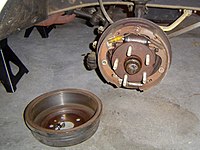
Photo from wikipedia
T lumbar interbody fusion (TLIF) is a well-established technique for achieving lumbar fusion from a posterior approach, requiring less nerve root retraction and reducing complication rates compared with posterior lumbar… Click to show full abstract
T lumbar interbody fusion (TLIF) is a well-established technique for achieving lumbar fusion from a posterior approach, requiring less nerve root retraction and reducing complication rates compared with posterior lumbar interbody fusions.1 The TLIF cage is integral to the technique, helping to restore normal disc height, enhance construct stiffness, and provide a surface and conduit for boney ingrowth.2 To that end, a multitude of cage designs have been proposed, with the bullet shape and crescent shape among the most popular.1 Although several studies have suggested that both designs are equally effective at achieving fusions,1–3 the crescent shape is superior due to improved correction of lumbar lordosis and disc height, improved stability owing to placement in the biomechanically stronger anterior endplate, theoretical potential for a larger graft footprint, and reduced migration rates. Several studies have documented a tendency toward improved restoration of lumbar lordosis and increased disc height with a crescent design. Kim and colleagues performed a retrospective analysis of 68 patients who underwent single-level TLIF with either a straight or curvilinear type cage. They found that the segmental lordosis was significantly greater in the curvilinear group at final follow-up (12mo), while the straight group failed to maintain restoration of lumbar lordosis at 6 months. They postulate this was secondary to a more anterior cage positioning in the curvilinear group.4 Lindley and colleagues retrospectively compared the results of 15 consecutive patients with crescent steerable cage TLIF and 10 patients with bullet TLIF. They found the mean postoperative Cobb angle in the crescent group improved from −5.3 to −13.7 degrees at a 12-month follow-up, whereas the bullet cage group did not improve (−4.8 to −5.7 degrees, P<0.01). In addition, they found that the postoperative disc height was significantly higher in the crescent group (10.9 vs. 8.5mm, P<0.01). They attributed these improvements to the anterior symmetrical placement of the cage in the interspace.5 Choi and colleagues reported lumbar lordosis and disc height parameters in a 40-patient prospective randomized clinical trial comparing banana-shaped and straight cages. They also demonstrated significantly better segmental lumbar lordosis improvement from preoperative measurements in the bananashaped group immediately postoperative (4.62 vs. 3.33 degrees, P=0.36), though there was no difference at 6 and 12 months. In addition, they demonstrated increased disc height versus preoperative measurements in the banana-shaped group lasting to a 12-month follow-up (2.25 vs. 1.34mm, P<0.0001).6 In addition to improved radiographic parameters, several authors have suggested that the crescent shape cage is biomechanically superior owing to its placement relative to the more robust anterior portion of the endplate. Multiple studies have demonstrated that increased density of the apophyseal endplate ring provides more resistance to compressive loads than the middle portion of the endplate.6–9 As one of the primary functions of TLIF cages is to confer stability to the construct so that fusion can occur, there is a strong theoretical advantage to placement of a cage in the strongest area of the endplate. Crescent-shaped implants are designed to be positioned along this anterior apophyseal ring, whereas bullet-shaped designs partially overlay the weaker central portion of the disk.2 Although several studies have failed to demonstrate improved biomechanical stiffness with the crescent-shaped design,1,2 Choi et al6 showed an increased subsidence rate when crescent cages are placed more posteriorly than bullet cages. This supports the idea that positioning with regard to the anterior endplate may be more important than implant design. However, with good technique, crescent-shaped implants may be easier to anteriorize, as was demonstrated in the Kim et al4 and Lindley et al5 series. Crescent-shaped grafts also have the potential for a larger graft footprint compared with bullet implants. This is attributable to the necessity of robust removal of the contralateral anterior disc for insertion of the implant. A cadaveric study by Rihn et al10 demonstrated that the contralateral anterior disk tends to be underresected in Received for publication December 29, 2018; accepted February 14, 2019. From the *Department of Orthopedics Surgery,Mayo Clinic, Rochester, MN; and †Walter Reed National Military Medical Center, Bethesda, MD. The views expressed in this article are those of the author(s) and do not necessarily reflect the official policy or position of the Department of the Army, Department of Navy, Department of Defense, or the United States Government. The authors declare no conflict of interest. Reprints: Nathan Wanderman, MD, Department of Orthopedics Surgery, Mayo Clinic, 200 1st St SE Rochester, MN 55905 (e-mail: wanderman. [email protected]). Copyright © 2019 Wolters Kluwer Health, Inc. All rights reserved. CONTROVERSIES IN SPINE SURGERY
Journal Title: Clinical Spine Surgery
Year Published: 2019
Link to full text (if available)
Share on Social Media: Sign Up to like & get
recommendations!